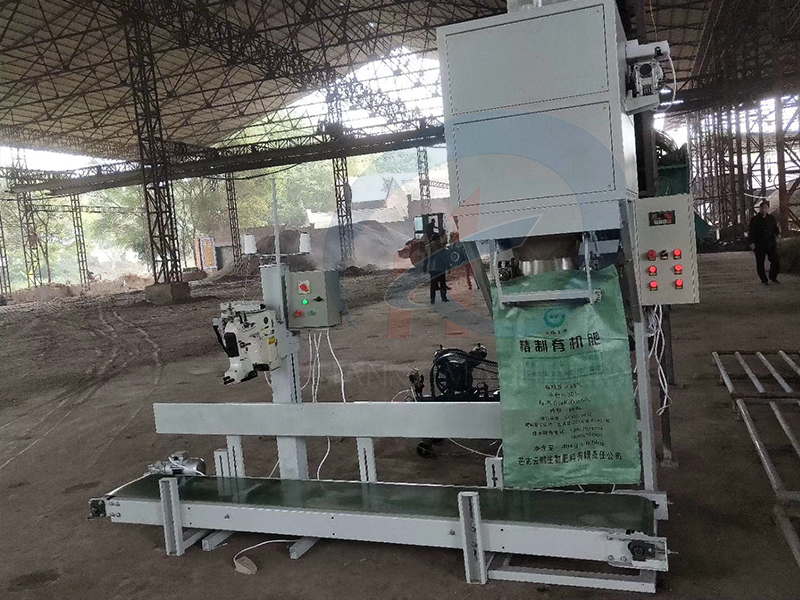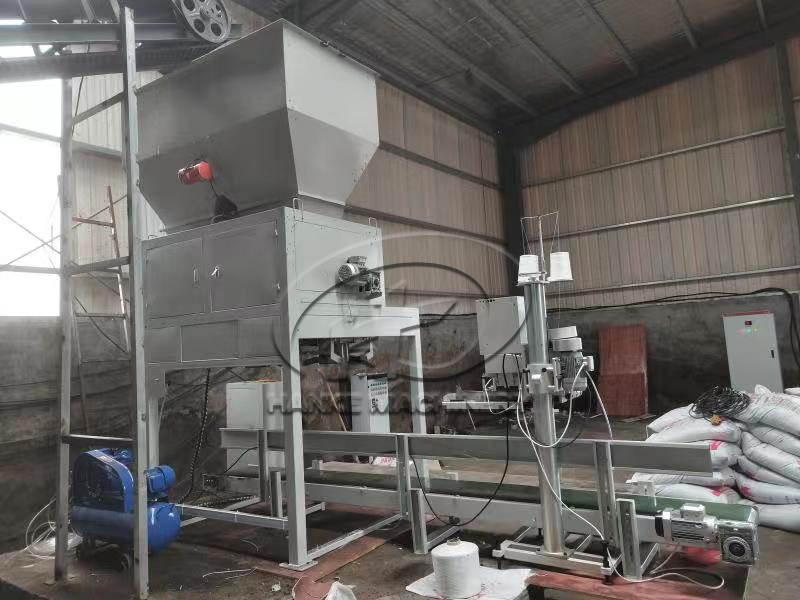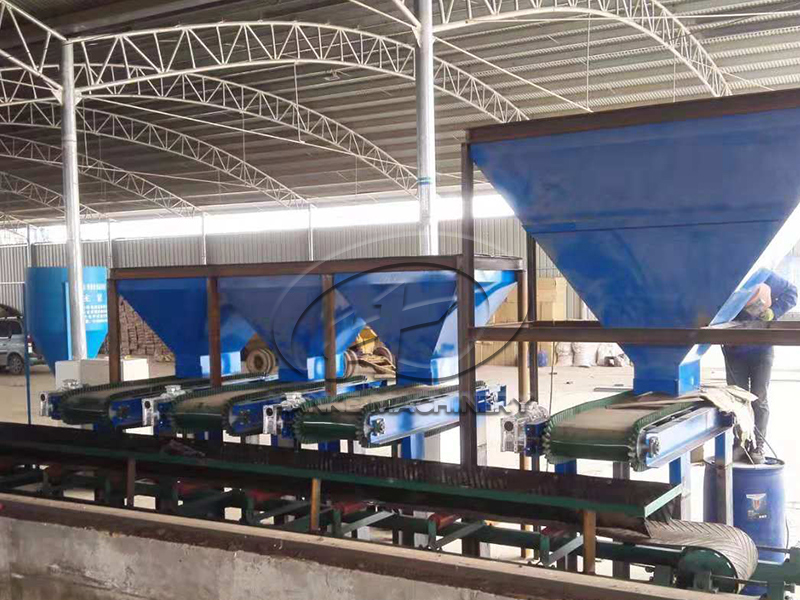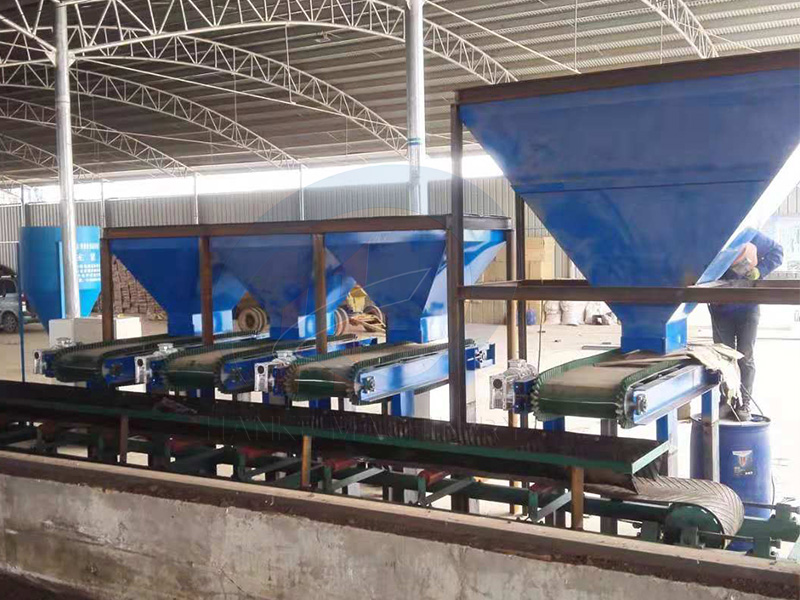 HOME > News > Industry News > What details should be noted when purchasing an organic fertilizer granule packaging machine?
HOME > News > Industry News > What details should be noted when purchasing an organic fertilizer granule packaging machine? Update time : 2025-09-16 Publisher:Zhengzhou Hanke Machinery
When purchasing an organic fertilizer granule packaging machine, it is necessary to take into account the physical characteristics of the organic fertilizer granules (such as being prone to moisture absorption, containing impurities, and uneven granules), the production scene requirements, and the long-term stability of use. Special attention should be paid to the following details to avoid problems such as poor packaging accuracy, frequent equipment failures, and insufficient adaptability in the later stage:
I. Core Performance and Material Compatibility Details
1.Particle characteristic adaptability
Organic fertilizer granules generally have characteristics such as irregular shapes, easy caking, and containing dust / fine impurities, etc. It is necessary to confirm whether the equipment has been optimized for these features.
Feeding port / Silo: Is it equipped with anti-bridging devices (such as vibration motors, stirring and arch-breaking mechanisms) to prevent blockage of feeding caused by particles sticking together due to viscosity?
Conveying channel: Are the pipes/conveyor belts that come into contact with the materials made of large diameter and smooth inner walls (such as 304 stainless steel), to reduce the residue of impurities and clogging of particles?
Screening pretreatment: If there are many impurities in the particles, it is recommended to choose a model with a built-in screening function (such as an internal filter screen) to prevent impurities from entering the metering system and affecting the accuracy.
2. Measurement Accuracy and Stability
Organic fertilizer packaging often involves medium to large capacity specifications of 20-50kg per bag. Excessive measurement errors will directly affect product quality and cost control, and the following points need to be noted:
Measurement method: Prefer the dual-speed feeding + weighing feedback mode (fast feeding at 80% - 90%, slow feeding to the target weight), to avoid overfeeding errors caused by fast feeding.
Sensor accuracy: Confirm the division value of the weighing sensor (such as 0.1kg/0.2kg) and the matching degree of the range (the range should cover the commonly used packaging weight and reserve 10%-20% redundancy), to avoid the use of small-range sensors for large-weight packaging, which may lead to accuracy attenuation.
On-site verification: The supplier is required to provide no-load/full-load verification plans. Standard weights can be used for on-site testing (for example, if set at 25kg, continuously test 10 bags, and the error must be controlled within ±0.2%, in line with industry standards).

II. Equipment Structure and Durability Details
1.Material selection (anti-corrosion, easy to clean)
Organic fertilizer granules may contain components such as humic acid and salts. Long-term contact with them can easily lead to equipment corrosion, which requires special attention.
Contact material components: 304 stainless steel must be used (not 201 stainless steel or carbon steel with paint), especially for the material bin, metering hopper, and sealing mechanism, to prevent rust from contaminating the material.
Non-contact components: It is recommended that the frame be made of carbon steel with plastic coating and rust-proof treatment to adapt to the humid and dusty environment in the workshop and extend the service life of the equipment.
Wear parts compatibility: Confirm the wear resistance of materials for parts such as conveyor belts, sealing strips, and motor bearings (for example, choose PU material for conveyor belts that is oil-resistant and anti-aging, and select food-grade silicone for sealing strips), and require suppliers to provide a list of wear parts and their replacement cycles.
2. The sealing method should be compatible with the packaging form.
The packaging of organic fertilizers mostly uses woven bags (with PE inner film) and composite film bags. The sealing mechanism should be confirmed according to the characteristics of the packaging materials.
For heat-sealing type: If composite film bags are used, it is necessary to confirm the controllable temperature range of the heat-sealing knife (generally 120-180℃) and the pressure adjustment function to avoid carbonization of the film bag due to excessively high temperature or an insecure seal due to excessively low temperature.
For the sewing type: If woven bags are used, a double-thread chain-stitch sewing machine (not a single-thread one) should be selected to ensure that the sealing strength meets the standard (the bag mouth can withstand a 50kg pull force without breaking after sewing), and the sewing lines should be smooth to prevent material leakage.
Exhaust function: Organic fertilizer granules may contain air in the gaps. After packaging, it can easily cause the bags to bulge and stack unstably. It is necessary to confirm whether the equipment is equipped with an automatic exhaust hole or vacuum-assisted function (optional for small packaging, and it is recommended to reserve an exhaust channel for large-capacity packaging).
III. Automation and Operational Convenience Details
1.Degree of automation and cost of manual intervention
If the production scale is large (such as over 500 tons per day), the reliance on manual labor needs to be reduced, with particular attention paid to:
Automatic bagging / bagging: Whether it supports mechanical bagging (suitable for woven bags) or automatic bagging mechanism (suitable for pre-made bags), to avoid the problems of low efficiency and inaccurate positioning in manual bagging.
Automatic weighing - sealing - conveying linkage: Confirm whether the equipment can be seamlessly connected with the subsequent belt conveyor and palletizer to form a "packaging - conveying - palletizing" assembly line, reducing manual handling.
Self-diagnosis of faults: Does it have an abnormal alarm function (such as when there is a lack of materials, bag jamming, or abnormal sealing temperature, the screen displays the fault point and stops the machine), to avoid batch non-conformity caused by omissions in manual inspection?
2. Convenience of operation and maintenance
Operation interface: Preferably choose touch screen + Chinese menu, support formula storage (such as presetting common specifications like 25kg, 40kg, 50kg, etc., no need to repeat debugging when switching), and have data recording function (such as recording the weight of each bag, total output, for easy traceability);
Cleaning and maintenance: Is the equipment designed with quick-release structures (such as the metering hopper and conveyor belt that can be quickly disassembled) to facilitate daily cleaning of residual particles? Are there reserved maintenance spaces for key components (such as motors and sensors) to avoid having to disassemble a large number of components during maintenance?
IV. Supplier Services and Risk Mitigation Details
1.On-site trial operation and customization capabilities
It is essential to conduct a trial run with actual materials: Take real organic fertilizer pellets to the supplier's factory for testing. Observe the smoothness of material feeding, measurement accuracy, and sealing effect of the equipment under real material conditions to avoid compatibility issues caused by only seeing the empty operation of the sample machine.
Customized communication: If there are special requirements (such as non-standard bag sizes, the need to print production dates/batch numbers, or limited workshop space), it is necessary to confirm whether the supplier can provide customization (such as adjusting equipment height, adding a coding module), and clearly define the customization cycle and additional costs.
2. After-sales Support and Training
Installation and commissioning: Confirm whether the supplier provides on-site installation and commissioning (rather than just remote guidance), especially for automated assembly lines, where the precision of the interconnection of each device needs to be calibrated on-site.
Warranty and Maintenance: Clearly define the warranty period (core components such as sensors and motors are recommended to have a warranty of 1-2 years, and the entire machine should have at least a 6-month warranty), and confirm whether there are nearby after-sales service outlets or spare parts warehouses to avoid excessively long waiting times for repairs when equipment malfunctions (such as a commitment to respond within 24 hours and arrive on-site within 48 hours).
Operation training: Require the supplier to provide on-site operation training (covering operators and maintenance personnel), and provide detailed operation manuals and troubleshooting guides to prevent equipment damage due to improper operation.
3. Case Studies and Word-of-Mouth Verification
Give priority to suppliers with industry cases in organic fertilizer. You can request the contact information of customers in the same industry and inquire about the actual usage of the equipment (such as failure rate and precision stability).
Avoid choosing "general-purpose packaging machines": Some suppliers directly use grain and feed packaging machines for organic fertilizer without optimizing them for the specific characteristics of organic fertilizer. This may lead to compatibility issues in the future. It is necessary to confirm whether the equipment model is clearly marked as "organic fertilizer dedicated" or has relevant modification records.
V. Cost and Long-Term Economic Efficiency Details
1.Avoid focusing only on the initial price.
It is necessary to calculate the unit packaging cost: for instance, low-priced equipment may have high energy consumption (such as excessive motor power) and frequent replacement of wear parts (such as conveyor belts that need to be replaced 2-3 times a month). In the long run, the total cost may be higher. It is recommended to compare the "equipment price + estimated maintenance cost for 5 years" of different suppliers and choose the model with better cost performance.
Capacity redundancy: When choosing equipment based on the capacity planning for the next 1-2 years, reserve 10%-20% capacity redundancy (for example, if the current daily output is 300 tons, select equipment with a capacity of 400 tons per day) to avoid the need for a second upgrade in the short term.
2. Energy Consumption and Environmental Compliance
Energy consumption indicators: Confirm the rated power of the equipment (such as single machine power 5-15kW), calculate the average daily energy consumption cost; give priority to energy-saving motors (such as YE3 high-efficiency motors), which can save electricity costs in the long term.
Environmental protection requirements: If the workshop has dust control requirements, it is necessary to confirm whether the equipment is equipped with dust collection devices (such as installing dust suction hoods at the feeding ports and sealing areas) to prevent the spread of particulate dust and meet environmental protection standards.
In conclusion, the core of purchasing an organic fertilizer granule packaging machine lies in "adaptability, stability, and ease of maintenance". It is necessary to verify the performance of the equipment from the details based on the actual material characteristics and production needs. At the same time, risks in the later stage can be avoided through the complete supplier services to ensure the long-term stable operation of the equipment and reduce production losses.

see details +

see details +

see details +

see details +

 Tel:+86 17319777703
Tel:+86 17319777703
 E-mail:hkautomaticpack@foxmail.com
E-mail:hkautomaticpack@foxmail.com
 Address:Xingyang City, Zhengzhou City, Henan Province.
Address:Xingyang City, Zhengzhou City, Henan Province.
Privacy Policy Copyright © Zhengzhou Hanke Machinery Equipment Co., Ltd Co., Ltd.